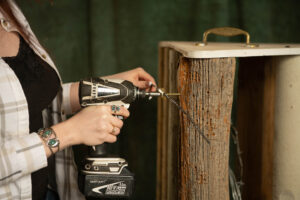No products in the cart.

Enter in our star of the show: the Class-3 HDG Fence Staples, a game-changing solution that ensures enhanced fence stability. When it comes to building and maintaining fences, don’t overlook the importance of secure and reliable fasteners. After all, the longevity of a fence largely depends on the quality of its components. These heavy-duty, barbed divergent, rust-resistant staples have revolutionized the fencing industry, providing hobbyists and professionals alike with a durable and efficient method for fastening fences. Using these babies will bring your fence to new heights! (Get it? New… Heights… Ahem, never mind.)
Class-3 HDG barbed divergent fence staples are a type of fastener specifically designed for securing fences. The term “Class-3” refers to the highest level of galvanization, ensuring maximum rust resistance and durability. These staples are meticulously manufactured using high-quality materials and advanced processes to withstand the harsh elements and demanding conditions often encountered in fencing projects. To identify them, look for their ends, or “barbs” that bend away from each other (as seen above). These staples provide superior holding power, preventing fence panels from coming loose or shifting over time.
The barbs on these staples dig deep into the wood, creating a tight and secure grip. This prevents the fence panels from sagging or moving, even in adverse weather conditions or high winds. And we’ve all done this during a demolition… While pulling apart cabinets or old wood on a property, we create a gap with a claw hammer, then wiggle the board back and forth until it finally comes loose. This is what the wind will do to a sagging fence. So the tighter your fence, the less opportunity for the elements to use those vulnerabilities to further weaken the structure.
Another notable benefit of Class-3 HDG fence staples is their exceptional durability and rust resistance. These staples are hot-dip galvanized, a process that involves immersing the staples in a molten zinc bath. The zinc coating acts as a barrier, preventing moisture and corrosive agents from reaching the steel core of the staple. This galvanized layer extends the lifespan of the staples, allowing them to withstand years of exposure to rain, snow, humidity, and other environmental factors without succumbing to rust or decay. So not only will they hold up, but they will keep their aesthetic appeal for an extended period, even in the harshest of weather conditions.
Class-3 HDG staples are specifically engineered to withstand substantial pressure and stress. Their robust construction ensures that they can handle the weight and movement of fence panels without bending or breaking. That saves you money and time, two things you don’t have an abundance of (because if you did -let’s face it- you wouldn’t be reading this blog).
Class 3 HDG barbed divergent staples find extensive use in various fencing applications. Whether you are constructing a privacy fence, livestock enclosure, garden border, or boundary fence, these staples are your go-to choice for secure fastening. Because of their versatility, they can be used with different types of fencing materials, including wood, composite, and vinyl.
To ensure optimal results and maximize the effectiveness of Class-3 HDG staples, here are a few installation tips to keep in mind:
Class-3 HDG barbed divergent fence staples have emerged as the go-to choice for hobbyists and professionals seeking high-quality, durable, and rust-resistant fastening solutions for fences. It almost makes the point of having a Class-1 or Class-2 staple rather silly. Which brings this to our final consideration: contractors.
There are going to be times that you are forced to hire a contractor. If this happens to be you, make sure you are paying attention to the hardware they use for their projects. If you’ve hired somebody to install a fence, they may be inclined to go with a lesser quality staple to cut their costs and bring their bid in lower than the competition. It may be tempting to save a few bucks on hardware, but ask the blunt questions and save yourself a headache. Regardless whether or not your are DIY or contracting somebody, you can pay for a quality job, or you can pay for a repair, but either way you will pay.
Got questions? Cat’s Claw Fasteners has the answers! Don’t hesitate to email our Head Cat Collector, Ralph, at ra***@***************rs.com. Stay updated with our blog posts and stay connected with us on social media – follow us on Facebook, Instagram, Pinterest, and Youtube!
About the writer: Jake
Jake Walker is Cat’s Claw Fasteners go-to guy for anything related to fencing, gates, installation, and materials! Thanks to his background as a professional fencing installer as well as content writer, combined with a bit of his British twang and ideas from across the pond, he keeps the audience captive. Don’t worry if you don’t understand his British slang or sense of humour; we don’t always understand him, and he doesn’t always fully understand us.
Get in touch of Jake via email at ra***@***************rs.com , be sure to use ATTN:Jake if you have any questions about all thing social, writing, fencing, or just want to make fun of his British accent.

© 2024 Cat's Claw Fasteners, LLC | All Rights Reserved - Built by Redemptive Software